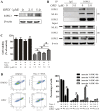Ophiopogonin D' induces RIPK1‑dependent necroptosis in androgen‑dependent LNCaP prostate cancer cells
- PMID: 31894265
- PMCID: PMC6959467
- DOI: 10.3892/ijo.2019.4945
Ophiopogonin D' induces RIPK1‑dependent necroptosis in androgen‑dependent LNCaP prostate cancer cells
Abstract
Ophiopogonin D' (OPD') is a natural compound extracted from Ophiopogon japonicus, which is a plant used in traditional Chinese medicine. Our previous study has indicated that OPD' exhibits antitumor activity against androgen‑independent prostate cancer (PCa), but the effects and the underlying molecular mechanism of action of OPD' in androgen‑dependent PCa were unclear. In the present study, OPD' induced significant necroptosis in androgen‑dependent LNCaP cancer cells by activating receptor‑interacting serine/threonine‑protein kinase 1 (RIPK1). Exposure to OPD' also increased Fas ligand (FasL)‑dependent RIPK1 protein expression. The OPD'‑induced necroptosis was inhibited by a RIPK1 inhibitor necrostatin‑1, further supporting a role for RIPK1 in the effects of OPD´. The antitumor effects of OPD' were also inhibited by a mixed lineage kinase domain‑like protein (MLKL) inhibitor necrosulfonamide. Following treatment with inhibitors of RIPK1 and MLKL, the effects of OPD' on LNCaP cells were inhibited in an additive manner. In addition, co‑immunoprecipitation assays demonstrated that OPD' induced RIPK3 upregulation, leading to the assembly of a RIPK3‑MLKL complex, which was independent of RIPK1. Furthermore, OPD' increased the expression of Fas‑associated death domain, which is required to induce necroptosis in LNCaP cells. OPD' also regulated the expression levels of FasL, androgen receptor and prostate‑specific antigen in a RIPK1‑dependent manner. These results suggested that OPD' may exhibit potential as an anti‑PCa agent by inducing RIPK1‑ and MLKL‑dependent necroptosis.
Figures







Similar articles
-
Ophiopogonin D', a Natural Product From Radix Ophiopogonis, Induces in Vitro and in Vivo RIPK1-Dependent and Caspase-Independent Apoptotic Death in Androgen-Independent Human Prostate Cancer Cells.Front Pharmacol. 2018 Apr 30;9:432. doi: 10.3389/fphar.2018.00432. eCollection 2018. Front Pharmacol. 2018. PMID: 29760660 Free PMC article.
-
Protein-Bound Polysaccharides from Coriolus Versicolor Induce RIPK1/RIPK3/MLKL-Mediated Necroptosis in ER-Positive Breast Cancer and Amelanotic Melanoma Cells.Cell Physiol Biochem. 2020 Jun 13;54(4):591-604. doi: 10.33594/000000242. Cell Physiol Biochem. 2020. PMID: 32531147
-
Inhibition of keratinocyte necroptosis mediated by RIPK1/RIPK3/MLKL provides a protective effect against psoriatic inflammation.Cell Death Dis. 2020 Feb 19;11(2):134. doi: 10.1038/s41419-020-2328-0. Cell Death Dis. 2020. PMID: 32075957 Free PMC article.
-
Small-Molecule Inhibitors of Necroptosis: Current Status and Perspectives.J Med Chem. 2020 Feb 27;63(4):1490-1510. doi: 10.1021/acs.jmedchem.9b01317. Epub 2019 Oct 31. J Med Chem. 2020. PMID: 31622096 Review.
-
RIPK1 in necroptosis and recent progress in related pharmaceutics.Front Immunol. 2025 Feb 11;16:1480027. doi: 10.3389/fimmu.2025.1480027. eCollection 2025. Front Immunol. 2025. PMID: 40007541 Free PMC article. Review.
Cited by
-
Ophiopogonin A Alleviates Hemorrhagic Shock-Induced Renal Injury via Induction of Nrf2 Expression.Front Physiol. 2021 Feb 1;11:619740. doi: 10.3389/fphys.2020.619740. eCollection 2020. Front Physiol. 2021. PMID: 33597892 Free PMC article.
-
Non-apoptotic cell death-based cancer therapy: Molecular mechanism, pharmacological modulators, and nanomedicine.Acta Pharm Sin B. 2022 Sep;12(9):3567-3593. doi: 10.1016/j.apsb.2022.03.020. Epub 2022 Apr 1. Acta Pharm Sin B. 2022. PMID: 36176912 Free PMC article. Review.
-
PPARG is a potential target of Tanshinone IIA in prostate cancer treatment: a combination study of molecular docking and dynamic simulation based on transcriptomic bioinformatics.Eur J Med Res. 2023 Nov 6;28(1):487. doi: 10.1186/s40001-023-01477-w. Eur J Med Res. 2023. PMID: 37932808 Free PMC article.
-
Targeting cell death pathways for cancer therapy: recent developments in necroptosis, pyroptosis, ferroptosis, and cuproptosis research.J Hematol Oncol. 2022 Dec 8;15(1):174. doi: 10.1186/s13045-022-01392-3. J Hematol Oncol. 2022. PMID: 36482419 Free PMC article. Review.
-
Necroptosis: A Pathogenic Negotiator in Human Diseases.Int J Mol Sci. 2022 Oct 22;23(21):12714. doi: 10.3390/ijms232112714. Int J Mol Sci. 2022. PMID: 36361505 Free PMC article. Review.
References
MeSH terms
Substances
LinkOut - more resources
Full Text Sources
Medical
Research Materials
Miscellaneous

